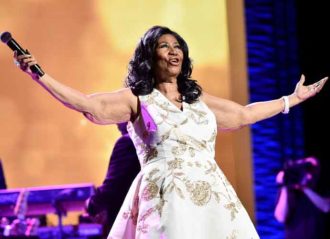SXSW 2019 VIDEO EXCLUSIVE: Carlie Guevara On ‘The Garden Left Behind,’ Trans Rights
Carlie Guevara stars in a powerful new film The Garden Left Behind that centers on a transgender woman.
The actress discussed the film exclusively with uInterview at the South by Southwest (SXSW) festival in Austin, Texas. Directed by Flavio Alves and written by Alves and John Rotondo, the movie is about a trans Mexican woman named Tina who is struggling to make a life for herself as an undocumented immigrant in New York City.
“Tina is someone who’s trying to find her life and [who is] finding her way in terms of how she fits into society and what her role is for herself,” Guevara explained. “I think [she’s] a character and it’s a story really about finding yourself.”
Ed Asner, Michael Madsen and Daniel Flaherty also star in The Garden Left Behind.
Guevara added that Tina struggles, throughout the film, to find people who share beliefs similar to her own. The actress also explained that she was able to keep a part of herself during filming.
“The easiest thing was that a lot of the wardrobe was my own,” she said, laughing. “I had a pair of shoes that I still have and that I probably should have worn. They’re so beat up and they’ve been on a movie now and I can still wear them and it’s awesome.”
Guevara revealed most of the film was shot in the Bronx, which helped her get the opportunity to see “quintessential New York scenes.”
“I saw an early cut of the film and it just read like a quirky, beautiful New York story,” she said.
The actress also explained that the film speaks to how much trans people, especially trans women, have struggled for years to receive adequate medical treatment.
50 CELEBRITIES WHO DIED IN 2018 – TRIBUTE SLIDESHOW
Guevarra admitted that the emotional scenes were among the most difficult to shoot, as the feelings she had to channel took much time and preparation.
Asner plays Tina’s psychologist Dr. Cleary in the film, and Guevara had nothing but praise for her co-star. She described Asner as “calm, wonderful and welcoming.”
“He really set the stage in terms of being comfortable and present in that moment,” Guevara said of Asner, adding that Madsen also strongly helped her feel at ease during filming.
Guevara stressed that the film is essentially about “fitting in and finding your own voice,” and that “anyone” can relate to her character’s struggles.
Full interview transcript below:
Q: Who’s your character in the film?
A: Tina… describing Tina: Tina is someone who’s trying to find her life and finding her own way in terms of how she fits into society and what her role is for her for herself. I think it’s a character and a story really about finding yourself. I think that her journey is a lot about self-discovery in terms of self, family, and community friends. She faces a lot of struggle — and I would say difficulties — trying to find people who believe what she believes and share her identities. She’s really trying to make that community for herself make that support system to heal whatever it is that she feels.
Q: What did you remember most from the shoot?
A: Easiest thing was a lot of the wardrobe was my own, so I had a pair of shoes that I still have and I probably should have worn. Their so beat-up and they’ve been on a movie now and I can still wear them and they’re awesome, that’s probably the easy part. The shoot itself was about 25 days in length all through New York City. A lot of it took place in the Bronx, which was really fun and interesting to find those I think “quintessential New York scenes.” I saw an early cut of the film and it just read like a quirky beautiful New York story, it was just amazing. I think the hardest part… a lot of the emotional scenes were hard, getting to that place to feel that emotion and to reflect that
in character was definitely challenging.
Q: What would you like people to know about your character?
A: I would imagine that Tina is struggling to convince a lot of people of what she already knows and I say convince because there’s a lot of pushback, but I would imagine that the pushback is false and born out of worry, really. It’s from love and so with Dr. Cleary, she’s working a lot to deal with trauma that she experienced in childhood and at the same time have his support for her medical transition, which is so necessary for a lot of us. It’s funny, there was a time in history when there was a script and you would go to the doctor and you’d say, you know, “I’m a woman, I’m a heterosexual woman” and you had to say certain things, and answer questions in way to get hormones. And so she’s navigating that story, a story that a lot of us have had, whether it’s any type of gatekeeping medical or not of playing the part. And with her grandmother, she’s struggling to find her utter love and to have her grandmother see her as who she really is.
Q: What was it like working with Ed Asner?
A: Ed Asner was calm, I got a lot out of it and working with him. He was so so wonderful and welcoming and he really set the stage in terms of just being comfortable and present in that moment, I enjoyed it. I enjoyed working with Michael Madsen as well, he was also someone who I guess maybe once you get to that level of work, you really set a precedence on set for calmness and just being at ease you know, you just flow into it.
Q: What do you think the message of the film is?
A: For the general public, it’s really a story about fitting in and finding your own voice. I think that it’s a universal story for Tina that anyone can relate to, facing any any kind of struggle that keeps you from being who you are and the specifics when it relates to her trans-identity comes out in her acquiring hormones and having the support of a medical practitioner. Ultimately it’s just her figuring out who she is and making the world see it.
RELATED ARTICLES
Get the most-revealing celebrity conversations with the uInterview podcast!




 Click here for the In Memoriam: 50 Celebrities Who Died In 2018 Slideshow
Click here for the In Memoriam: 50 Celebrities Who Died In 2018 Slideshow




Leave a comment